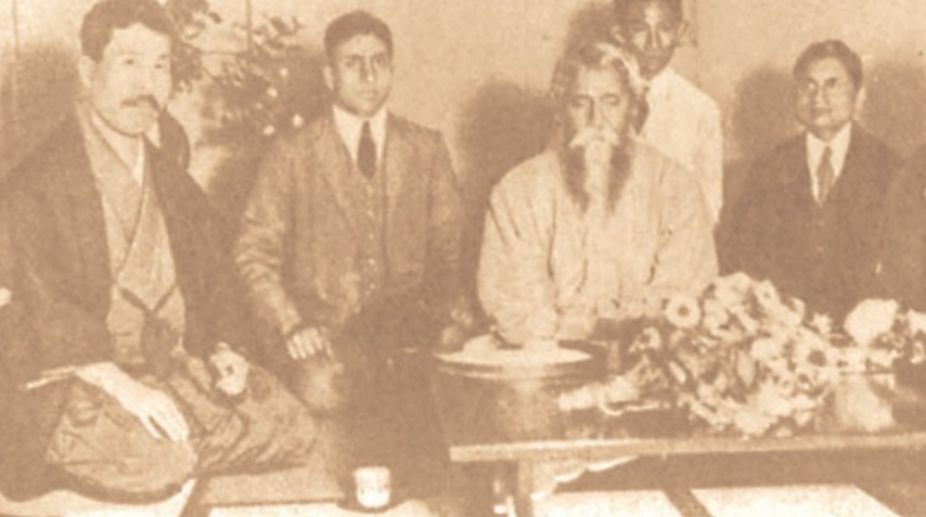Recent developments in the USA, Britain and certain other parts of the world, including India and South Asia in general, are based on a skewed perception of the idea of nationalism. This can have dangerous implications for peace, security and human welfare. Tagore’s idea of nationalism and the differences that had developed between the poet and a section of Japanese intellectuals are fairly well known; what is not always recognised is the subsequent change in the views of these intellectuals about the relevance of Tagore’s ideas for the contemporary world. Tagore’s views on nationalism, as expressed in his lectures during his visits to Japan, China, the US as well as in his speeches and writings in India, seem to have spurred a fresh evaluation of the traditional concept of nationalism as it had developed in the West, not only in Japan but also in other parts of the world as well.
The poet visited Japan in 1916, 1924 and in 1929, but his interest in that country had deeper roots. He was a great admirer of Japanese art and culture, and appreciated the country’s economic and scientific achievements, and industrial progress. He particularly appreciated Japan’s “great art”, marked by simplicity and harmony. He rejoiced at the news of the Japanese victory in the war against Russia (1905). In his reckoning, it represented to him the victory of the spirit of Asian nationalism, based on the cultural values of Asia, over the evils of Russian (Western) imperialism. He had also developed friendship with many Japanese intellectuals, preeminently Okakura who stayed with the Tagore family in Calcutta during his visit to India in 1902 and completed his book The Ideals of the East in collaboration with Sister Nivedita. It was published in England in 2003.
Advertisement
After he won the Nobel Prize in 1913, Rabindranath was invited to visit Japan, but he was reluctant to go apparently because he was deeply hurt by the untimely death of Okakura in 1910. He was distressed no less by Japan’s gradual drift towards militarism, going by his letter to CF Andrews written on 11 January 1915. He wrote: “I have given up Japan and I feel more and more sure, it is not for me” (Quoted by Krishna Dutta and Andrew Robinson in Rabindranath Tagore: The Myriad Minded Man, 1996). Nevertheless he visited Japan in 1916 and his host was the reputed Japanese newspaper, Asahi Shinbum. He was welcomed by the Japanese when he landed in Kobe on 25 May 1916 and his articles and speeches were widely reported in the Japanese press, making him almost a household name. He addressed large audiences in Osaka and Tokyo Universities. In his presentation on nationalism at Tokyo University, he expressed dismay over what he considered to be the signs of militant nationalism which ran counter to the cultural and literary traditions of Japan that emphasised simplicity and harmony. “West is dangerous for Japan is not the imitation of the outer features of the West, but the acceptance of the motive force of Western nationalism as her own”. (Rabindranath Tagore, Nationalism in Japan. In his view, the belligerent and chauvinistic nationalism that had developed in the West was responsible for the war in Europe two years earlier and he pleaded with the Japanese to shun the path of violence.
Tagore’s ideas were criticised in Japan, particularly by those who had studied and worked in the US and subsequently returned to Japan, such as Noguchi. He was a poet who had worked in the US and had taught in a university. Noguchi also criticised Romain Rolland as an escapist, because he was praising Tagore from his safe home in Switzerland, rather than serving his homeland at the critical hour. After Tagore delivered his lectures in Japan criticising nationalism, the Japanese weekly Chronicle published an unsigned article titled “Tagore and his critics” in which the author wrote: “Tagore’s contempt for mere nationalism is naturally the bitterest pill for the Japanese to swallow since from the cradle to the grave the importance of being Japanese in firmly impressed upon them. How can they put nationalism behind them? Surely such can only be preached by a man whose country has lost its independence ~ by an inhabitant of a pale and decaying land, where all things droop to ruin” (Quoted in Debojyoti Bandyopadhyay; Rabindranather Jatiyotabad-Birodhi Swadeshprem, 2015, p. 65), Perhaps this was a reflection of the views held by a large segment of theJapanese population at the time, after Tagore had delivered his lecture criticising nationalism. Although Tagore’s criticism of the Western concept of nationalism did not go down well with some Japanese intellectuals, he visited Japan again in 1924 and in 1929. His fears over the rise of militarism in Japan seemed to be confirmed during the Manchurian crisis (1931).
Nevertheless, he and his friends in India believed that there were still many in Japan ~ artists and intellectuals in particular ~ who were sceptical of the government’s policies and by developing mutual understanding with them Japan could be saved from this slide into an aggressive militarism that had characterised the country’s foreign and defence policies during the third decade of the last century.
With this objective, he invited Japanese scholars and artists to come to Santiniketan and work in Visva-Bharati University. He also invited Noguchi to India in 1935-36 and was treated as a national guest wherever he went. But differences between Tagore and Noguchi surfaced again after the outbreak of the Sino-Japanese war in December 1937. When the Japanese forces attacked Nanking, the terrible massacre of Nanking shocked the poet who condemned it in unequivocal terms. He expected Noguchi to condemn the brutality. But the Japanese poet, in separate letters to Tagore and Gandhi sought to justify this on patriotic grounds by using the rhetoric of Asia for the Asians which failed to satisfy the Indians. The letters exchanged between Tagore and Noguchi that were published in Amrita Bazar Patrika, reveal the differences between the two on the issue of nationalism as it had developed in Japan during the 1930s. (Nobuko Yamasaki, “The Letters Between Tagore and Noguchi, 1938” in Patrick Chogan and Lalita Pandit (ed); Rabindranath Tagore: University and Tradition, 2003).
Tagore’s views on nationalism as expressed in his speeches in the US in 1916 and in China in 1924 were severely criticised in both these countries as well, although they were appreciated by Albert Einstein and Romain Rolland.
Nor for that matter were Tagore’s views on nationalism appreciated in his own country. Sharp differences had developed between him and many nationalist leaders, including Mahatma Gandhi, in the wake of the noncooperation movement. The Mahatma failed to convince him that the kind of nationalist movement being waged in India to gain freedom would indeed make Indians “free” in the true sense of the term.
What were the reasons behind this? So far as China was concerned, there was a specific historical context against which the Chinese views of India and Indians were developed ~ the use of Indian soldiers by the British in their battles with the Chinese for nearly a century after the first opium war of 1841. Indians had played an important role in the annexation of Hong Kong, as part of the British Indian Army.
(To be concluded)











